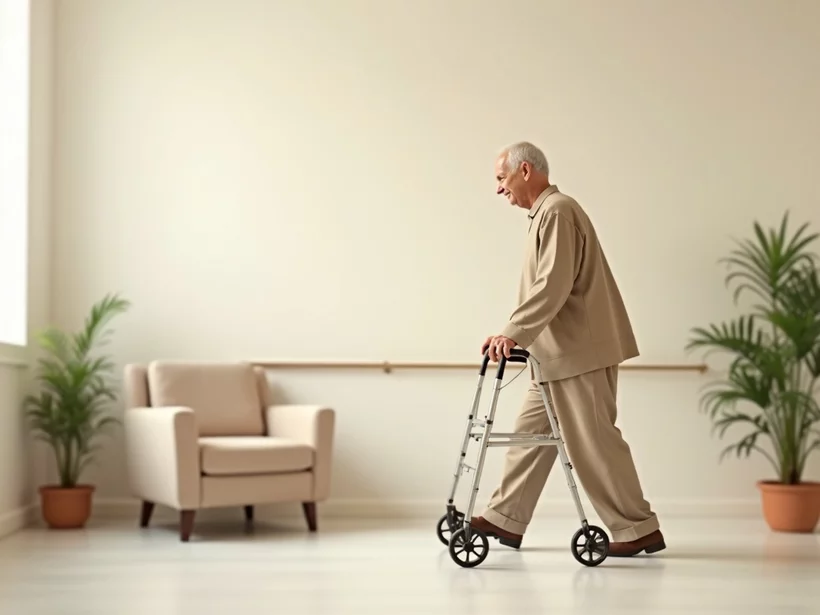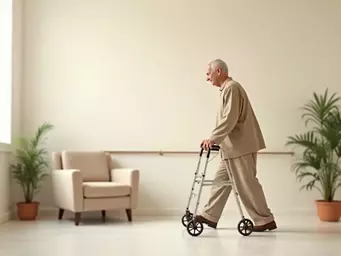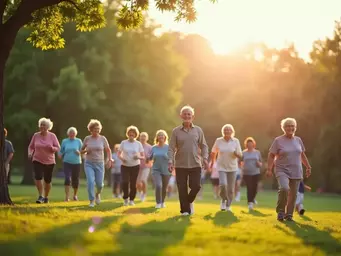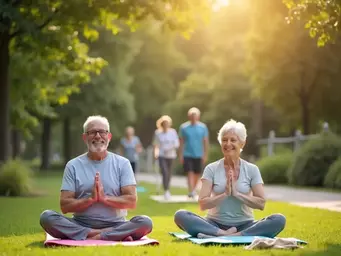Strategies to Prevent Falls in Seniors

According to the Australian Institute of Health and Welfare, falls are responsible for around 30% of hospital admissions among older Australians. This staggering statistic serves as a crucial reminder of the importance of fall prevention strategies for our aging population. By understanding the risks and implementing proactive measures, we can significantly enhance the quality of life for seniors.
Key Takeaways
- Falls account for approximately 30% of hospital admissions for individuals aged 65 and over, highlighting the need for effective prevention strategies.
- Physical injuries from falls include hip fractures, wrist fractures, and head injuries, which can lead to long-term consequences like reduced mobility.
- Psychological effects such as the fear of falling can increase dependency and social isolation among older adults.
- Key risk factors for falls include physical health issues (strength and balance), environmental hazards, medications, and vision and hearing impairments.
- Nutrition plays a vital role in fall prevention; a balanced diet supports muscle strength and overall health.
- Family caregivers are essential in supporting seniors with fall prevention through health monitoring, encouraging safe practices, and implementing home modifications.
- In case of a fall, seeking medical attention, engaging in rehabilitation, and providing emotional support are crucial for effective recovery.
Statistics on Falls and Injuries in Seniors
Understanding the alarming statistics about falls among older adults can help motivate preventative measures. Below are some critical figures to consider:
30% of older Australians experience a fall each year
A significant portion of the elderly population is affected by falls annually, indicating a pressing need for awareness and prevention strategies.
50% of those who fall will fall again within 12 months
This statistic underscores the cyclical nature of falls and the importance of effective intervention and support.
Over 40% of hospital admissions for seniors are due to falls-related injuries
The healthcare implications of falls are severe, leading to hospitalization and increased healthcare costs.
Understanding the Importance of Fall Prevention in Older Adults
As we age, the risk of falling becomes more significant, and understanding why fall prevention is crucial is a key aspect of healthy aging. Falls can significantly impact the well-being of older adults, leading to serious injuries, loss of independence, and a decreased quality of life. At Cairns Active Ageing Solutions, we recognize that every step counts, and having effective fall prevention strategies in place is essential for older adults to thrive! For more detailed insights, consider exploring our resources on ensuring home safety for seniors.
When we look at statistics, we can see just how serious the issue of falls is. According to the Australian Institute of Health and Welfare, falls are one of the leading causes of injury among older Australians, accounting for about 30% of all hospital admissions for those aged 65 and over. This staggering number highlights the need for a proactive approach to ensure our seniors remain safe and active in their communities.
The Impact of Falls on Aging Populations
Falls can lead to a variety of health issues that can impact older adults' lives. Not only do they often result in physical injuries such as fractures or head trauma, but they can also lead to psychological effects like fear of falling again, which can limit mobility and social interactions. Have you ever noticed how a fall can change a person's outlook? I've seen it happen in my work, and it's a stark reminder of how important it is to take preventative measures.
Here are some key impacts of falls on older adults:
- Physical Injuries: Common injuries include hip fractures, wrist fractures, and head injuries.
- Psychological Effects: Many seniors develop a fear of falling, which can lead to isolation.
- Increased Healthcare Costs: Hospital visits and rehabilitation can strain finances and resources.
Statistics on Falls and Injuries in Seniors
Statistics paint a clear picture of the fall landscape among seniors. In fact, research shows that one in three older adults falls each year. This statistic is a clarion call for action! Understanding these numbers can motivate us to implement preventative measures.
Here are a few eye-opening figures regarding falls among seniors:
- 30% of older Australians experience a fall each year.
- 50% of those who fall will fall again within 12 months.
- Over 40% of hospital admissions for seniors are due to falls-related injuries.
Long-term Consequences of Falls: Health and Psychological Effects
The long-term effects of falls can ripple through many aspects of an older adult's life. Physically, injuries can lead to a decline in mobility and independence. Psychologically, the fear of falling can trigger a cycle of inactivity, leading to further physical decline. This cycle is something I am passionate about breaking through education and preventative strategies. Taking a proactive stance can help in preventing falls for Cairns seniors and beyond.
To highlight the importance of addressing both health and psychological effects, consider these consequences:
- Reduced Mobility: Many seniors become less active, leading to muscle weakness.
- Increased Dependency: A fear of falling can lead to avoidance of daily activities, increasing reliance on caregivers.
- Social Isolation: With fewer outings comes loneliness, which can impact mental health.
Identifying the Common Risk Factors for Falls
Understanding the risk factors for falls is crucial in preventing them. At Cairns Active Ageing Solutions, we emphasize the need to identify these risks early on. With the right awareness, we can create strategies tailored to individual needs. Here are the common risk factors you should be aware of:
- Physical Factors: Issues with strength, balance, or gait can significantly increase fall risk.
- Environmental Hazards: Cluttered homes or poor lighting can lead to accidents.
- Medications: Some medications can cause dizziness or drowsiness.
- Vision and Hearing Impairments: These can make navigating spaces more challenging.
- Impact of Nutrition: Poor nutrition can lead to weakness and increase fall risk.
Physical Factors: Strength, Balance, and Gait Issues
One of the most significant contributors to falls among older adults is related to physical health. Strength, balance, and gait issues can create a perfect storm for accidents. Regular exercise can help improve these areas, reducing the likelihood of falls.
These physical factors include:
- Muscle Weakness: Lack of strength can affect balance and stability.
- Balance Issues: Conditions like vertigo can make staying upright a challenge.
- Gait Problems: A shuffling walk can increase the risk of stumbling.
Environmental Hazards: Home Safety Concerns
Our home environment plays a crucial role in fall prevention. Simple hazards can lead to accidents that could otherwise be avoided. It’s essential to conduct regular home safety assessments to make necessary adjustments. Here are some common environmental hazards to consider:
- Cluttered Walkways: Items left on the floor can create tripping hazards.
- Poor Lighting: Dim light can make it hard to see obstacles.
- Loose Rugs or Mats: These can easily slip and cause falls.
Medications and Their Side Effects
Certain medications can have side effects that increase fall risk. Dizziness, drowsiness, or balance issues can stem from medications commonly prescribed to older adults. Regular medication reviews are vital to ensure safety. Here are some medication-related concerns to keep in mind:
- High Blood Pressure Medications: These can cause dizziness when standing abruptly.
- Antidepressants: Some can impact balance and coordination.
- Muscle Relaxants: These can lead to drowsiness and impaired mobility.
Vision and Hearing Impairments: A Hidden Risk
Vision and hearing impairments can greatly affect an older adult's ability to navigate their environment safely. Poor vision can lead to not seeing hazards, while hearing loss can prevent someone from hearing warning signals. I often encourage my clients to get regular check-ups to keep these issues in check!
Consider the following:
- Vision Problems: Issues like cataracts or glaucoma can impair sight.
- Hearing Loss: Not hearing someone calling out can lead to dangerous situations.
- Regular Check-Ups: Encourage routine visits to eye and hearing specialists.
Impact of Nutrition on Fall Risk
Did you know that nutrition plays a significant role in fall prevention? A balanced diet supports muscle strength and overall health, which can help reduce the risk of falling. At Cairns Active Ageing Solutions, we emphasize the importance of proper nutrition for maintaining strength and balance.
Here are some nutritional tips to keep in mind:
- Hydration: Staying hydrated can prevent dizziness.
- Calcium and Vitamin D: These are important for bone health.
- Protein Intake: Adequate protein helps maintain muscle strength.
Quick Summary
Here's a brief recap of the key points discussed so far:
- Falls are a leading cause of injury among older adults, with approximately 30% experiencing a fall each year.
- Physical, environmental, and medication-related factors significantly increase the risk of falls.
- Family caregivers play an essential role in fall prevention by supporting seniors in implementing safety measures and promoting physical activity.
- Nutrition is vital for maintaining strength and balance, contributing to overall fall prevention strategies.
Frequently Asked Questions (FAQs)
- Q: Why is fall prevention crucial for older adults?
- A: Fall prevention is crucial because falls are a leading cause of injury among older Australians, accounting for approximately 30% of hospital admissions for those aged 65 and over. They can lead to serious physical injuries, psychological effects like fear of falling, and a decreased quality of life.
- Q: What are the common physical impacts of falls?
- A: Common physical impacts include hip fractures, wrist fractures, and head injuries. These can result in reduced mobility and independence.
- Q: How do falls affect older adults psychologically?
- A: Falls can lead to a fear of falling again, which often results in reduced mobility, social isolation, and increased dependency on caregivers. This can significantly impact mental health and well-being.
- Q: What are the main risk factors for falls?
- A: Key risk factors include physical issues (strength, balance, gait), environmental hazards (clutter, poor lighting), side effects from medications, and vision or hearing impairments. Poor nutrition can also contribute to weakness, increasing fall risk.
- Q: What role do family caregivers play in fall prevention?
- A: Family caregivers are essential in fall prevention. They monitor health changes, encourage safe practices (like using assistive devices), promote physical activities, help with home modifications, and maintain open communication to ensure tailored safety measures.
- Q: What steps should be taken after an older adult experiences a fall?
- A: After a fall, it's crucial to seek medical attention to assess injuries. Physical rehabilitation helps restore strength and mobility, emotional support addresses fear and anxiety, and occupational therapy can help regain independence in daily activities.
Incorporating Caregiver Perspectives in Fall Prevention
Family caregivers play a crucial role in supporting seniors as they navigate the challenges of maintaining safety and independence. As someone who has worked closely with caregivers at Cairns Active Ageing Solutions, I've seen firsthand the impact they have on fall prevention strategies. Their involvement not only fosters a sense of security for older adults but also enhances the effectiveness of safety measures put in place.
Caregivers often help seniors implement safety measures at home, ensuring that they can move around freely and confidently. This includes everything from rearranging furniture to eliminate tripping hazards to encouraging regular exercise to build strength and balance. It's essential for caregivers to be proactive in assessing the home environment and making adjustments that can prevent falls before they happen. This proactive approach is key to preventing falls in the elderly effectively.
The Essential Role of Family Caregivers
Family caregivers are often the unsung heroes in the lives of older adults. Their support can make a world of difference in fall prevention efforts!
- Monitoring Health: Caregivers keep an eye on their loved ones' physical health, helping to detect changes that may indicate an increased risk of falls.
- Encouraging Safe Practices: They can promote safe practices such as the use of assistive devices like canes or walkers when necessary.
- Engaging in Physical Activities: Caregivers can encourage participation in activities that enhance strength and balance, such as yoga or tai chi.
- Communication: They maintain open communication about the needs and concerns of seniors, ensuring that safety measures are tailored effectively.
Supporting Seniors in Implementing Safety Measures
When it comes to fall prevention, implementing safety measures is key, and family caregivers are pivotal in this process. Simple adjustments can significantly reduce fall risks and enhance the quality of life for seniors.
- Home Modifications: Consider installing grab bars in bathrooms and ensuring that all areas are well-lit to prevent accidents.
- Regular Check-Ins: Regularly checking in on the senior's physical condition and discussing any concerns they might have helps address potential risks early.
- Using Technology: Encouraging the use of technology, such as personal alarms, can offer an additional layer of safety and reassurance.
The dedication of family caregivers cannot be overstated. They often provide not just physical support but also emotional encouragement, which can empower seniors to take an active role in their own safety and well-being.
Resources and Tools for Caregivers
Caregivers can benefit from a variety of resources that offer guidance and support in their essential roles. At Cairns Active Ageing Solutions, we recognize the importance of equipping caregivers with the tools they need. Embracing active aging together can lead to more fulfilling and safer lives for seniors.
- Workshops: Educational workshops can provide caregivers with insights into effective fall prevention strategies and safety measures.
- Online Resources: Access to articles and videos on home safety adjustments and exercises can help caregivers stay informed.
- Support Groups: Joining support groups allows caregivers to share experiences and tips with others in similar situations.
Being equipped with the right resources not only helps caregivers feel more confident in their ability to support their loved ones but also enhances the overall safety for seniors.
Post-Fall Recovery and Rehabilitation Strategies
Even with the best prevention strategies, falls can still happen. Therefore, having a clear recovery plan is vital for ensuring seniors bounce back effectively.
Here are some key guidelines for effective recovery after a fall:
- Seek Medical Attention: Always consult a healthcare professional after a fall to assess any potential injuries.
- Physical Rehabilitation: Engaging in tailored rehabilitation exercises can help restore strength and mobility.
- Emotional Support: Providing emotional support and counseling can help address any fear or anxiety stemming from the fall.
- Occupational Therapy: Working with an occupational therapist can help seniors regain independence in daily activities.
At Cairns Active Ageing Solutions, we emphasize the importance of a holistic approach to recovery. By focusing on both physical and emotional aspects, we aim to support seniors in regaining their confidence and independence. This holistic approach often includes various forms of physical activity benefits for seniors to aid in their recovery and long-term well-being.
Conclusion: Empowering Aging Populations to Reduce Fall Risks
In conclusion, it’s clear that a **multi-factor approach** is essential for effective fall prevention. By integrating caregiver perspectives, implementing safety measures, and focusing on recovery, we can create a safer environment for our aging population.
Let’s encourage action! Explore available resources and support systems that can help you or your loved ones stay safe and independent. Remember, every step taken today can lead to a more secure tomorrow!
Recap of Key Points
Here is a quick recap of the important points discussed in the article:
- Importance of Fall Prevention: Falls are a leading cause of injury among older adults, emphasizing the need for effective prevention strategies.
- Health and Psychological Impact: Falls lead to physical injuries and psychological effects, such as fear and isolation, which can decrease quality of life.
- Common Risk Factors: Key risk factors include physical issues, environmental hazards, medication side effects, and sensory impairments.
- Role of Family Caregivers: Caregivers are vital in fall prevention, helping to assess risks and implement safety measures.
- Recovery Strategies: After a fall, it's important to seek medical attention, engage in rehabilitation, and provide emotional support.







